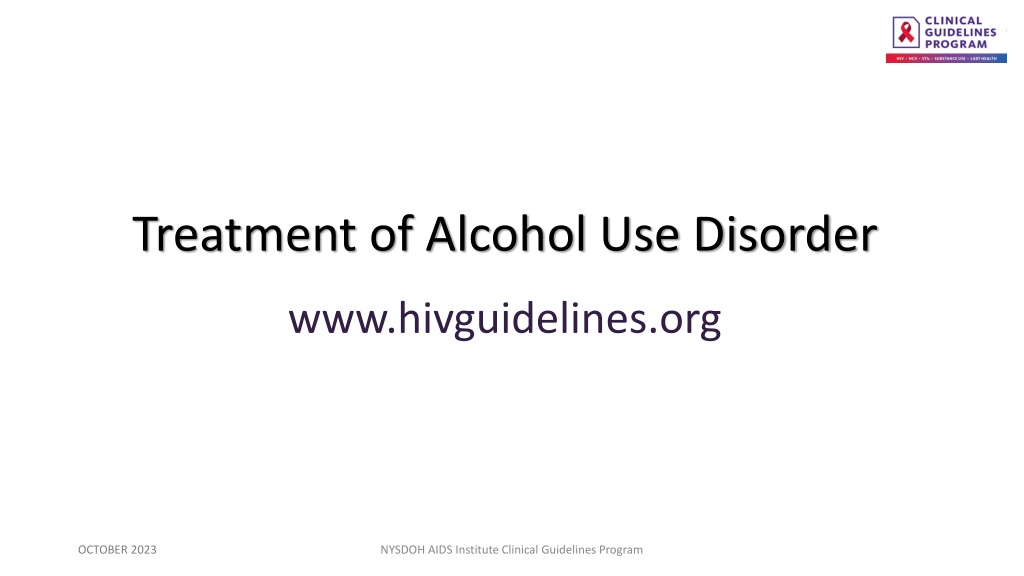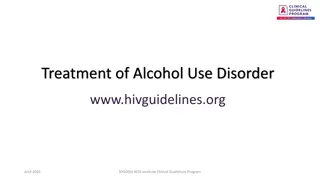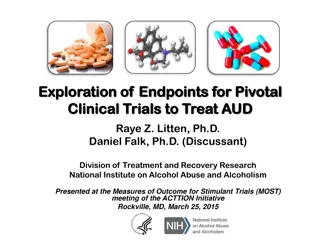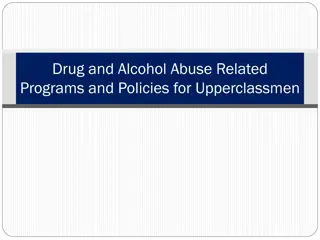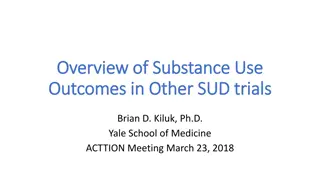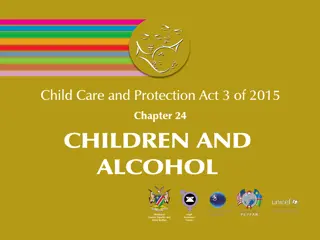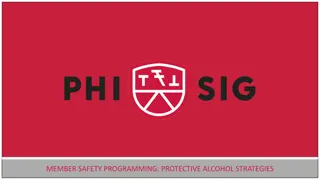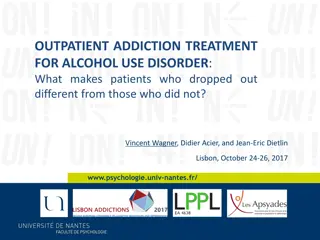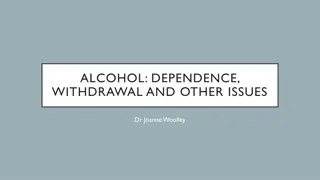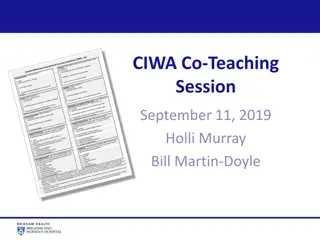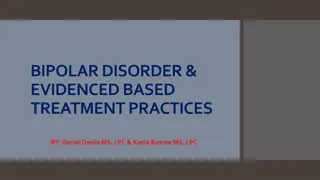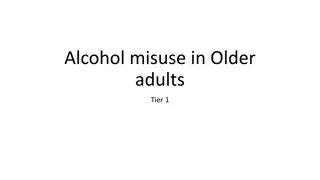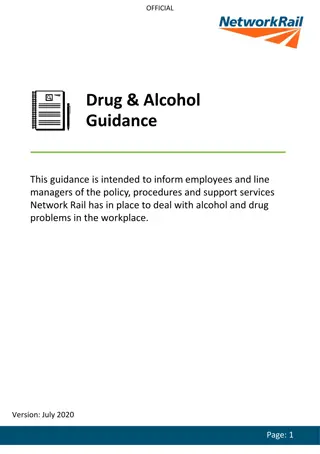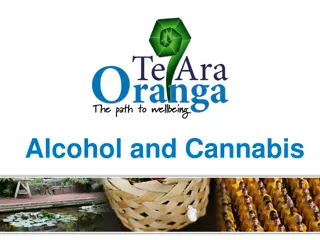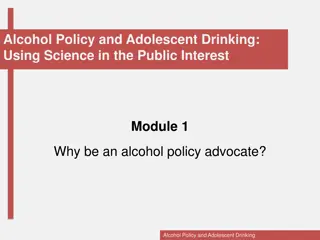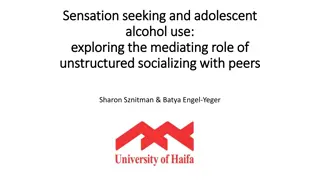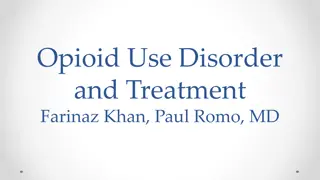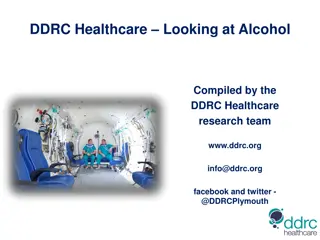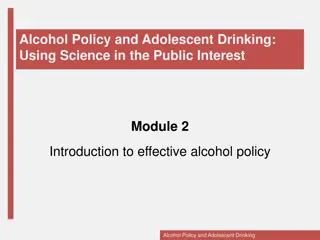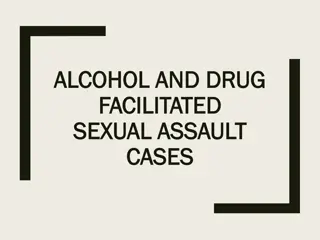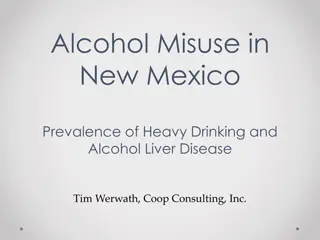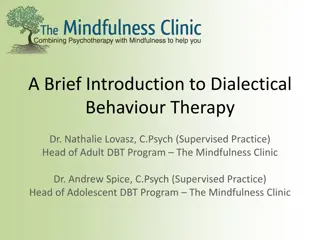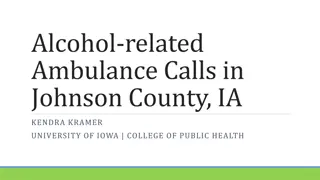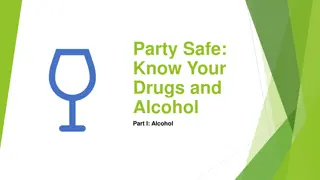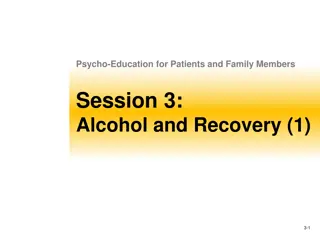Comprehensive Guidelines for Alcohol Use Disorder Treatment
The clinical guidelines outlined in this document aim to increase awareness among clinicians regarding the risks associated with Alcohol Use Disorder (AUD) and emphasize the benefits of diagnosing and treating AUD in adults. Recommendations include offering pharmacologic and behavioral treatments based on the severity of AUD, engaging in shared decision-making for treatment goals, and managing alcohol withdrawal syndrome effectively. The guidelines also highlight the importance of patient education on treatment options and settings, such as outpatient primary care and specialty addiction treatment facilities. By promoting a harm reduction approach, these guidelines provide practical strategies for reducing the negative consequences of alcohol use.
Download Presentation

Please find below an Image/Link to download the presentation.
The content on the website is provided AS IS for your information and personal use only. It may not be sold, licensed, or shared on other websites without obtaining consent from the author. Download presentation by click this link. If you encounter any issues during the download, it is possible that the publisher has removed the file from their server.
E N D
Presentation Transcript
Treatment of Alcohol Use Disorder www.hivguidelines.org OCTOBER 2023 NYSDOH AIDS Institute Clinical Guidelines Program
Purpose of This Guideline Increase clinicians awareness of the risks associated with AUD of any severity and the benefits of diagnosing and treating AUD in adults Increase clinicians knowledge of available evidence-based treatments for AUD and withdrawal management and increase the availability of AUD treatment in ambulatory care settings in New York State Promote a harm reduction approach to AUD treatment through implementation of practical strategies and ideas for reducing the negative consequences associated with alcohol use (see NYSDOH AI guideline Substance Use Harm Reduction in Medical Care) OCTOBER 2023 NYSDOH AIDS Institute Clinical Guidelines Program www.hivguidelines.org
Recommendations: Treatment Considerations Who to Treat Clinicians should recommend and offer pharmacologic treatment to individuals with moderate or severe AUD. (A1) Clinicians should recommend behavioral treatment for individuals with AUD and refer as appropriate. (A1) Treatment Goals Clinicians should inform patients with AUD about all available pharmacologic and behavioral treatment options and all available treatment settings, including outpatient primary care and addiction specialty treatment (intensive outpatient, inpatient, and residential treatments). (A3) Clinicians should engage in shared decision-making with patients to set specific treatment goals, including harm reduction. (A3) OCTOBER 2023 NYSDOH AIDS Institute Clinical Guidelines Program www.hivguidelines.org
Recommendations: Treatment Considerations continued Treatment Selection Clinicians and patients should choose a pharmacologic agent based on evidence-based recommendations; patient preference; current level of alcohol use; experience of cravings; risk of withdrawal syndrome; available support; available formulations; potential adverse effects; dosing schedules (adherence may be increased with once-daily dosing); medical or psychiatric comorbidities that may preclude use of a specific agent or require increased monitoring, including hepatic or renal dysfunction; depression or anxiety; a concomitant SUD; and concomitant opioid use or misuse. (A3) Alcohol Withdrawal Syndrome Before initiating AUD treatment, clinicians should assess the need for withdrawal management. (A3) Mild to moderate withdrawal syndrome can be managed in the outpatient setting; severe withdrawal syndrome or other complicating conditions should be referred for inpatient management. See the American Society of Addiction Medicine (ASAM) Clinical Practice Guideline on Alcohol Withdrawal Management 2020. Follow-up If a patient taking acamprosate or naltrexone for AUD continues or resumes alcohol use, the clinician should continue to prescribe the medication, advise the patient to continue to take it, and discuss possible modifications to treatment goals. (A3) OCTOBER 2023 NYSDOH AIDS Institute Clinical Guidelines Program www.hivguidelines.org
NIAAA Definition of Recovery NIAAA Definition of Recovery Recovery is a process through which an individual pursues both remission from AUD and cessation from heavy drinking. An individual may be considered recovered if both remission from AUD and cessation from heavy drinking are achieved and maintained over time. For those experiencing alcohol-related functional impairment and other adverse consequences, recovery is often marked by the fulfillment of basic needs, enhancements in social support and spirituality, and improvements in physical and mental health, quality of life, and other dimensions of well-being. Continued improvement in these domains may, in turn, promote sustained recovery. OCTOBER 2023 NYSDOH AIDS Institute Clinical Guidelines Program www.hivguidelines.org
Goals of Treatment: Harm Reduction Approach Staying engaged in care, which can also facilitate prevention, diagnosis, and treatment of other conditions Reducing alcohol use Reducing high-risk behaviors (e.g., driving while intoxicated, engaging in condomless sex while drinking, using other substances while drinking, engaging in violent behavior toward intimate partners and others) Improving quality of life and other social indicators, such as employment, stable housing, and risk of incarceration Improving mental health OCTOBER 2023 NYSDOH AIDS Institute Clinical Guidelines Program www.hivguidelines.org
Recommendation: Behavioral Treatment Clinicians should recommend behavioral treatment for patients with AUD and refer as appropriate (A1). The type of treatment is based on the individual patient s experience and preference, social factors, treatment availability, and insurance, among other factors. OCTOBER 2023 NYSDOH AIDS Institute Clinical Guidelines Program www.hivguidelines.org
Recommendations: Preferred Pharmacologic Treatment Clinicians should recommend oral acamprosate or oral or injectable XR naltrexone as the preferred medication for treating AUD. (A1) See Table 1: Preferred Pharmacologic Treatment of AUD in Nonpregnant Adults. Acamprosate For the best treatment response, clinicians should initiate treatment with acamprosate as soon as patients have abstained from alcohol use and within 7 days. (A3) Clinicians should perform serum CrCl testing before initiating treatment with acamprosate (A3); if CrCl is between 30 and 50 mL/min or eGFR is between 30 and 59 mL/min/1.73 m2, clinicians should adjust the dose according to the prescribing information or choose another medication. (A2) Contraindications: CrCl <30 mL/min or eGFR <30 mL/min/1.73 m2 OCTOBER 2023 NYSDOH AIDS Institute Clinical Guidelines Program www.hivguidelines.org
Recommendations: Preferred Pharmacologic Treatmentcontinued Oral or Injectable Long-Acting Extended-Release Naltrexone Because active alcohol use is not a contraindication to naltrexone therapy, clinicians should initiate naltrexone even if patients continue to use alcohol. (A1) Before initiating treatment with injectable XR naltrexone, clinicians should prescribe an oral trial of naltrexone (50 mg once daily for at least 3 days) to ensure that patients tolerate the medication. (A3) Clinicians should recommend XR naltrexone if adherence to an oral regimen is a concern. (B3) Contraindications: Concomitant use of opioid analgesics or opioid agonists (e.g., methadone or buprenorphine), current physiologic opioid dependence, acute opioid withdrawal, reaction to a naloxone challenge test, or a positive urine test result for opioids. (A2) For a patient with AUD who recently used opioids, the clinician should administer d a naloxone challenge and confirm that the patient does not react, to ensure that opioids have been cleared from the system (see NYSDOH AI guideline Treatment of Opioid Use Disorder > Naltrexone). (A2) OCTOBER 2023 NYSDOH AIDS Institute Clinical Guidelines Program www.hivguidelines.org
Table 1: Preferred Pharmacologic Treatment of AUD in Nonpregnant Adults Medication Dosage Considerations Preferred Medications Initiate treatment as soon as patients have abstained from alcohol use and within 7 days. Counsel patients about the importance of adherence. Perform serum CrCl testing before initiating treatment; adjust dose if CrCl is between 30 and 50 mL/min or eGFR is between 30 and 59 mL/min/1.73 m2. Contraindications: CrCl <30 mL/min or eGFR <30 mL/min/1.73 m2; see package insert for dose adjustments based on CrCl. Acamprosate oral (Campral) Initial and maintenance: 666 mg 3 times per day OCTOBER 2023 NYSDOH AIDS Institute Clinical Guidelines Program www.hivguidelines.org
Table 1. Preferred Pharmacologic Treatment of AUD in Nonpregnant Adults continued Medication Dosage Considerations Preferred Medications Abstinence from alcohol is not required for initiating and maintaining treatment. Recommend the injectable formulation for patients who have problems with adherence to the oral regimen. Abstinence from opioids is required for treatment. For patients who use alcohol and opioids, see recommendations in NYSDOH AI guideline Treatment of Opioid Use Disorder > Naltrexone. Prescribe with caution in patients with abnormal liver function 3 to 5 times the upper limit of normal. The extent of liver abnormalities on baseline testing may guide continued testing or referral to an experienced liver specialist. Contraindications: Concomitant use of opioid analgesics or opioid agonists (e.g., methadone or buprenorphine), current physiologic opioid dependence, acute opioid withdrawal, a reaction to a naloxone challenge test, or a positive urine test result for opioids Naltrexone oral (Revia) Initial and maintenance: 50 mg once daily If adverse events occur, clinicians can consider a reduced dose of 25 mg once daily. 100 mg daily has been used and well tolerated in studies. XR Naltrexone, long-acting injectable (Vivitrol) Initial: 50 mg oral naltrexone once daily for at least 3 days Maintenance: 380 mg intragluteal injection every 28 days OCTOBER 2023 NYSDOH AIDS Institute Clinical Guidelines Program www.hivguidelines.org
Recommendations: Alternative Pharmacologic Treatment For individuals with AUD who have not responded to or are intolerant of naltrexone or acamprosate, or who prefer a different medication, clinicians should discuss and offer disulfiram, gabapentin, or topiramate. (A3) See Table 2: Alternative Pharmacologic Treatment of AUD in Nonpregnant Adults. Disulfiram Clinicians should emphasize the importance of avoiding alcohol consumption in all forms to patients before initiating and when taking disulfiram. (A3) Clinicians should perform liver function testing, including AST/ALT levels before initiating disulfiram. In patients with AST/ALT levels > 3 to 5 times the upper limit of normal, avoid treatment with disulfiram. (A3) Contraindications: Recent or concomitant use of metronidazole, alcohol, or alcohol-containing preparations (e.g., cough syrups, tonics). Disulfiram is contraindicated in the presence of severe myocardial disease or coronary occlusion and psychoses. OCTOBER 2023 NYSDOH AIDS Institute Clinical Guidelines Program www.hivguidelines.org
Recommendations: Alternative Pharmacologic Treatment continued Gabapentin or Topiramate If gabapentin or topiramate is the agent of choice, clinicians should not require abstinence before initiation, because active alcohol use is not a contraindication to either medication. (A3) OCTOBER 2023 NYSDOH AIDS Institute Clinical Guidelines Program www.hivguidelines.org
Table 2. Alternative Pharmacologic Treatment of AUD in Nonpregnant Adults Medication Dosage Considerations Alternative Medications Disulfiram oral (multiple brands) Initial and maintenance: 500 mg once daily for 1 to 2 weeks. Reduce to 250 mg once daily. Abstinence from alcohol before initiating and while taking disulfiram is required. Advise patients to initiate disulfiram only after 12 hours of abstinence. Inform patients of the disulfiram-ethanol reaction. Reinforce complete abstinence from any form of alcohol. Perform baseline liver testing before initiating disulfiram treatment; in patients with AST/ALT levels >3 to 5 times the upper limit of normal, avoid treatment with disulfiram. Contraindications: Recent or concomitant use of metronidazole, alcohol, or alcohol-containing preparations (e.g., cough syrups, tonics). Disulfiram is contraindicated in the presence of severe myocardial disease or coronary occlusion and psychoses. Note: Concomitant use of disulfiram and alcohol, even small amounts, can result in the following adverse effects: flushing, throbbing in the head and neck, respiratory difficulty, nausea, copious vomiting, sweating, thirst, chest pain, palpitations, dyspnea, hyperventilation, tachycardia, hypotension, syncope, marked uneasiness, weakness, vertigo, blurred vision, and confusion. Severe reactions may result in respiratory depression, cardiovascular collapse, arrhythmias, myocardial infarction, acute congestive heart failure, unconsciousness, convulsions, and death. OCTOBER 2023 NYSDOH AIDS Institute Clinical Guidelines Program www.hivguidelines.org
Alternative Pharmacologic Treatment of AUD in Nonpregnant Adults, continued Medication Dosage Considerations Alternative Medications Gabapentin oral (multiple brands) Initial: 300 mg once daily Titrate: Increase in increments of 300 mg Maintenance: Up to 3,600 mg daily, divided in 3 doses; dose is based on response and tolerance Abstinence from alcohol is not required for initiating or maintaining treatment. Caution: Gabapentin may be misused alone for psychoactive effect or combined with opioids, benzodiazepines, alcohol or other substances to intensify intoxication. Topiramate oral (multiple brands) Initial: 25 mg once daily Titrate: Increase dose by 50 mg increments each week to a maximum of 400 mg daily administered in 2 divided doses Maintenance: 200 to 400 mg daily divided into 2 doses Abstinence from alcohol use is not required for initiating or maintaining treatment. A dose reduction by half is recommended for adult patients with CrCl 70 mL/min or eGFR 70 mL/min/1.73 m2. See package insert for full prescribing information. OCTOBER 2023 NYSDOH AIDS Institute Clinical Guidelines Program www.hivguidelines.org
Gabapentin Misuse Gabapentin can induce a sense of euphoria when taken in combination with other substances, especially opioids, benzodiazepines, or alcohol, and there is the potential for misuse. Individuals may take gabapentin for recreational purposes, to control mood or anxiety, to intensify the effects of substances, or for intentional self-harm. Gabapentin has been increasingly associated with opioid-related overdose deaths, and caution is required when prescribing gabapentin for individuals with comorbid AUD and OUD. If there is a strong concern about gabapentin misuse or diversion, clinicians may want to schedule monthly or more frequent follow-up visits and medication counts. OCTOBER 2023 NYSDOH AIDS Institute Clinical Guidelines Program www.hivguidelines.org
Need Help? Need Help? NYSDOH AIDS Institute Clinical Guidelines Program www.hivguidelines.org
Access the Guideline Access the Guideline www.hivguidelines.org > Treatment of Alcohol Use Disorder Also available: Printable pocket guide and PDF NYSDOH AIDS Institute Clinical Guidelines Program www.hivguidelines.org
